Kalamata Olive Trees
Kalamata olive trees originally belong to the land near the Ionian Sea, located in the Kalamata region of Southern Greece. They are fairly popular because of the large-size, deep reddish-purple olives they grow.
The olives grown on these trees are brined in red wine vinegar for curing. Additionally, they are used as table salt, and people also stuff them with various ingredients. Moreover, a moderate amount of oil is also extracted from Kalamata olives. Hence, the Kalamata cultivar can be a valuable addition to your orchards and kitchen gardens. They are also mass-planted for commercial purposes.
The leaves of Kalamata are large, twisty, and torpedo-skinned, raising their landscape appeal. Considerable growth, high yields, and low-rooting capabilities are some of its other noteworthy features.
- Fruiting Specimen
- Bloom (Spring)
- Moderate Growth
- Color (Grey-to-Green)
- Olive Oil (A soft, fruity but slightly bitter flavor)
- Landscape and Commercial
Care and Maintenance
Like several other olive cultivars, Kalamata olive trees can grow well in ordinary, well-drained, and slightly alkaline soils. For best results, they are grown in combination with other olive species. Adequate watering is important in the first few months of growth to ensure effective root development. The watering frequency can be reduced later because the tree becomes drought-tolerant once it’s established. Don’t forget to protect newly planted trees from extreme temperatures.
| Quick Facts | |
| Origin | Greece |
| Scientific Name | Olea Europaea ‘Kalamata’ |
| Family | Oleaceae |
| Tree Type | A Single & Multi-Trunk Fruiting Specimen |
| Common Names | The Olive Tree, Kalamata, Olea Europaea, Kalamon |
| Height | (Insert) |
| Toxicity | Non-Toxic |
| Light | Full Sun |
| Watering | Drought-Tolerant |
| Soil | Well-Drained, Nutrient-Poor Soil |
| Hardiness | Hardy down to 20 to 30 °F |
| Foliage | Gray-to-Green |
| Growth | Moderate |
| Olive Oil | Soft, fruity, and slightly bitter flavor |
Don’t Take Our Word, Hear What Our Customers Say!



Interested? We’d love to hear from you!
Call us at 707-732-6152 for a free consultation!
Looking for something else? We might have it for you...
Arbequina Olive Trees
Arbosana Olive Trees
Ascolana Tenera Olive Trees
Cerignola Olive Trees
Coratina Olive Trees
Itrana Olive Trees Kalamata Olive Trees
Koroneiki Olive Trees
Leccino Olive Trees
Little Ollie Dwarf Olive Trees
Majestic Beauty Olive Trees
Manzanillo Olive Tree
Maurino Olive Tree Mission Olive Tree
Pendolino Olive Trees
Picholine Du Gard Olive Trees
Picual Olive Trees
Sevillano Olive Trees
Swan Hill Olive Trees
Wilsonii Olive Trees
Zitoun Olive Trees